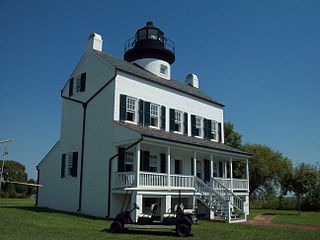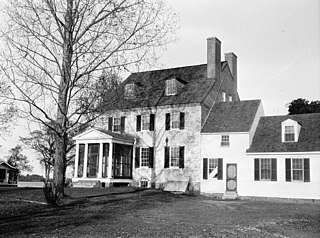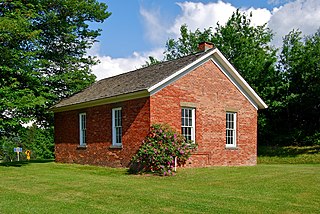
St. Mary's County, established in 1637, is a county located in the U.S. state of Maryland. As of the 2010 census, the population was 105,151. Its county seat is Leonardtown. The name is in honor of Mary, the mother of Jesus.

The City of College Park is in Prince George's County, Maryland, United States, and is approximately four miles (6.4 km) from the northeast border of Washington, D.C. The population was 30,413 at the 2010 United States Census. The 2020 census count was 34,740. It is best known as the home of the University of Maryland, College Park. Since 1994, the city has also been home to the National Archives at College Park, a facility of the U.S. National Archives, as well as to the National Oceanic and Atmospheric Administration (NOAA) Center for Weather and Climate Prediction (NCWCP) and the Food and Drug Administration (FDA) Center for Food Safety and Applied Nutrition (CFSAN).

Leonardtown is a town in and the county seat of St. Mary's County, Maryland, United States. The population was 2,930 at the 2010 census. Leonardtown is perhaps most famous for the national oyster-shucking championship that is held annually at the St. Mary's County fairgrounds.

Lexington Park is a census-designated place (CDP) in St. Mary's County, Maryland, United States, and the principal community of the Lexington Park, Maryland Micropolitan Statistical Area. The population was 11,626 at the 2010 census.

One-room schools were commonplace throughout rural portions of various countries, including Prussia, Norway, Sweden, the United States, Canada, Australia, New Zealand, the United Kingdom, Ireland, and Spain. In most rural and small town schools, all of the students met in a single room. There, a single teacher taught academic basics to several grade levels of elementary-age children. While in many areas one-room schools are no longer used, it is not uncommon for them to remain in developing nations and rural or remote areas. Examples include remote parts of the American West, the Falklands, and the Shetland Islands.
The Howard County Public School System (HCPSS) is the school district that manages and runs the public schools of Howard County, Maryland. It operates under the supervision of an elected, eight-member Board of Education. Dr. Chao Wu is the Chairman of the Board. Michael J. Martirano has served as the Superintendent since May 2017.

St. Charles College was a minor seminary in Catonsville, Maryland, originally located in Ellicott City, Maryland.

Chana School is a Registered Historic Place in Ogle County, Illinois, in the county seat of Oregon, Illinois. One of six Oregon sites listed on the Register, the school is an oddly shaped, two-room schoolhouse which has been moved from its original location. Chana School joined the Register in 2005 as an education museum.

Price Public Elementary School, now known as Price Public Community Center and Swift Museum, is a former African-American school in Rogersville, Tennessee. It currently serves as a community center and home of the Swift Museum.

Porto Bello is a historic home located at Drayden, St. Mary's County, Maryland. It is a 1+1⁄2-story gambrel-roofed Flemish bond brick house built after 1742. It is located on a portion of the first grant of land recorded in the province of Maryland: West St. Mary's Manor, one of the nine original Maryland Manors. Its name commemorates the Battle of Porto Bello (1739).
Hopewell is an unincorporated community in St. Mary's County, Maryland, United States. It lies at an elevation of seven feet.

The District #6 Schoolhouse, also known locally as the Little Red Schoolhouse or the Lincoln School, located in Brunswick, New York, United States, is a one-room schoolhouse built c. 1830 or 1837 that was home to grades one through eight until the consolidation of Brunswick (Brittonkill) Central School District in 1952. It was added to the National Register of Historic Places (NRHP) on July 3, 2008 and a dedication ceremony for the accomplishment was held on June 12, 2009.

The Little Outfit Schoolhouse is a ranch school that was built in 1940 in southeastern Arizona. It is located on the Little Outfit Ranch in San Rafael Valley, about ten miles east-southeast of Patagonia, in Santa Cruz County, which borders Mexico on the south and is about 80 miles from Arizona's eastern border with New Mexico.

Fishing Creek Schoolhouse is a historic school located in the Villas census-designated place, of Lower Township, Cape May County, New Jersey, United States. The schoolhouse was built in 1888 and added to the National Register of Historic Places on March 6, 1980.

Cherry Hill School is a historic school for African-American students located at Hilton Head Island, Beaufort County, South Carolina. It was built about 1937, and is a simple, gable-front rectangular one-room frame and weatherboard-sided schoolhouse on an open brick-pier foundation. The school operated until all African-American children attended the new consolidated elementary school in 1954. The community built and helped maintain the school consisted of the descendants of the former-slave town of Mitchelville, the first community to mandate education in the South. The St. James Baptist Church purchased the school in 1956. The church extended and renovated the building in 1984.

Saint Aloysius on the Ohio is a Roman Catholic parish in the Sayler Park neighborhood of Cincinnati, Ohio, United States. The parish is part of the Archdiocese of Cincinnati. It is named after St. Aloysius Gonzaga and located near the Ohio River.
Lakeland High School was a high school for black children located in the Lakeland community of Prince George's County, Maryland, United States, now a part of College Park. It was the second high school for black children in the county. The building is currently used as a church.

The Espanola Schoolhouse is a one-story; one-room rural school building that has survived from the Jim Crow racial segregation-era. It is the last standing one-room schoolhouse in Flagler County. It is located at 98 Knox Jones Avenue, Bunnell, Florida 32110.

Des Moines Township No. 7, also known as Cole School, is a historic building located northeast of Boone in rural Boone County, United States. The brick one-room schoolhouse was completed in 1888. The use of brick suggests the people in this area were either people of some wealth or there was a larger population who could draw on a broader base of financial resources. Student records were not kept until the year after the school opened. At that time there were 19 students who were between the ages of 5 and 16. Nellie Harvey was the first teacher, and she and those who came after her worked with the students from first grade to eighth. In addition to being a schoolhouse, the building also served as a voting place, a community center, and a storm shelter. As the number of farm families in the area diminished the enrollment in the school declined. Educational leaders began to advocate for better educational offerings and improved school buildings. In 1920 the Iowa General Assembly passed laws to improve rural schools. During the Great Depression more families left the farms and the school closed in 1933. Two of the students who attended the school when it opened had sons in the final class of eight students.

A two-room schoolhouse is a larger version of the one-room schoolhouse, with many of the same characteristics, providing the facility for primary and secondary education in a small community or rural area. While providing the same function as a contemporary primary school or secondary school building, a small multi-room school house is more similar to a one-room schoolhouse, both being architecturally very simple structures. While once very common in rural areas of many countries, one and two-room schools have largely been replaced although some are still operating. Having a second classroom allowed for two teachers to operate at the school, serving a larger number of schoolchildren and/or more grade levels. Architecturally, they could be slightly more complex, but were still usually very simple. In some areas, a two-room school indicated the village or town was wealthier and more prosperous.


















